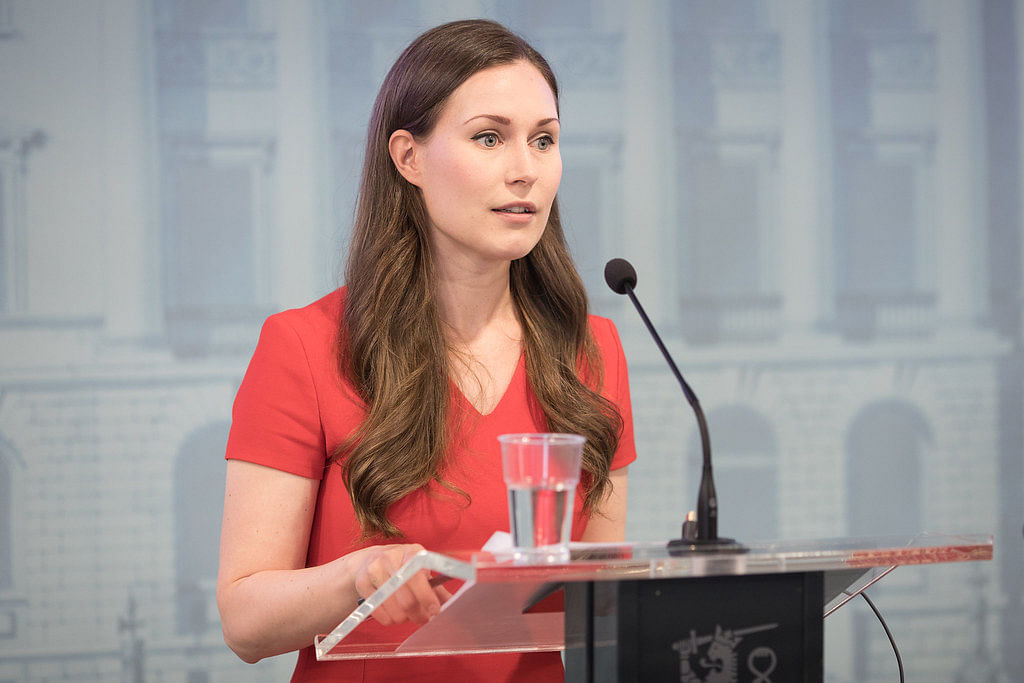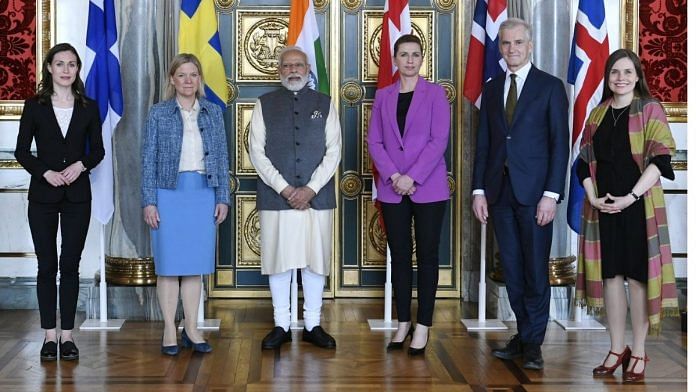New Delhi: Prime Minister Narendra Modi Wednesday held a series of bilateral meetings with four women leaders of Nordic countries at the second India-Nordic summit in Denmark’s Copenhagen during which he exchanged views on regional and global development.
This summit saw the participation of Prime Minister Katrin Jakobsdottir of Iceland, Prime Minister Sanna Marin of Finland, Prime Minister Magdalena Andersson of Sweden and Prime Minister Mette Frederiksen of Denmark — all of whom have mobilised the global climate movement in some way or the other.
While Frederiksen has made cutting carbon emissions her prime goal, Andersson — also an economist — has focussed on strengthening the fair distribution of resources in her country.
Iceland’s Jakobsdottir is an environmentalist who has protested against climate change since she was a teenager. Marin, who is the youngest serving PM in the world, has passionately tried to combat climate change.
This diverse set of women leaders, known for their progressive politics, are slowly changing the world. They are at the forefront of a revolution, directed at improving lives and inspiring a better future for all.
But who are these women? And what has made them popular in the world around?
Prime Minister of Iceland Katrin Jakobsdottir

Iceland’s Katrin Jakobsdottir has been painted a staunch feminist in her country who secured a second-term just last year after serving as prime minister since 2017. The 46-year-old former journalist is believed to be both the result and the cause of Iceland having the highest level of gender equality, an honour the nation has held for the last nine years. She is the second woman to head Iceland’s government, improving its already soaring level of gender equality, investment in healthcare, education and transport infrastructure.
Jakobsdottir has been a fervent supporter of the environment, a sentiment that arose when she witnessed the construction of a controversial hydroelectric dam in eastern Iceland in the 2000s. It was through demonstrations that she began her stint of political participation, later joining the youth of the Left-Green Movement in 2002. She became the vice president of the party the following year and has served as president since 2013. She has mobilised Iceland to address climate change by reducing emissions, restoring wetlands, planting trees, switching to renewable fuels — all in order to make her country carbon neutral by 2045.
Prime Minister Sanna Marin of Finland

In 2019, Sanna Marin at the age of 34 became the youngest serving prime minister in the world. The left-leaning leader is the third woman to hold the PM’s position in Finland and currently leads a coalition headed entirely by women. Marin has described herself being raised in a “Rainbow Family,” a term describing LGBTQ+ households.
Marin has discussed in her past interviews how her upbringing had a profound effect on her politics that taught her about the importance of equality. She even went to introduce a new gender policy in Finland that extended family leave for both parents in order to improve gender equality. It’s no surprise then that Finland is considered one of the most progressive countries in the world in treating people of different sexual orientation.
The star of the Social Democratic Party, Marin is considered progressive within her own party due to her ideas on ways to combat climate change, provision of quality health care and social welfare — that has been on top of her agenda since she came into power.
Prime Minister Magdalena Andersson of Sweden

Leader of the Social Democratic Party of Sweden Magdalena Andersson became the first female prime minister when she narrowly secured parliamentary support in 2021. The 54-year-old economist on the occasion had vowed to reform the welfare state to further support low-income workers and ensure that they enjoyed decent conditions.Andersson’s appointment was fraught with problems as her coalition partners had attempted to block her candidacy for endorsing a budget that was too far left, promising extra paid leave for parents among other provisions. Even when Andersson was the Finance Minister, she was a proponent of women and abortion rights.
Her speeches used to be consistently characterised by jobs and fair distribution of resources. There is no doubt about her experience as a career politician who always had a reputation as a strong negotiator and a straight talker. However, the Harvard graduate is yet to convince voters that her policy ideas are sound in order to continue her term before the September 2022 general election.
Prime Minister Mette Frederiksen of Denmark

Mette Frederiksen of Denmark’s centre-left Social Democratic party had promised to work toward cutting carbon emissions (as much as 70%) by 2030 on becoming the country’s youngest ever prime minister in 2019. Her plans have only intensified her actions in tackling climate change, promoting forestation and increasing levies on use of plastic. Hailing from a family who has been active in trade unions, Frederiksen’s goal has also been set on boosting welfare spending and social justice.
Though she was expected to usher in an era aimed at softening some policies on migrants after four years of conservative rule in Denmark, the country under her is slowly moving towards introducing some of the toughest rules in Europe for asylum seekers. The immigration measures that continue to remain in place in the country even after she came to power include a ban on face covering, affecting Muslim, and measures forcing young children of some migrants to undergo instruction in “Danish values.”
Even in her opening speech on becoming the PM, the 44-year-old talked about how she wanted to “protect and defend” the Danish society, which she held in high-esteem and wished to be more cohesive.



